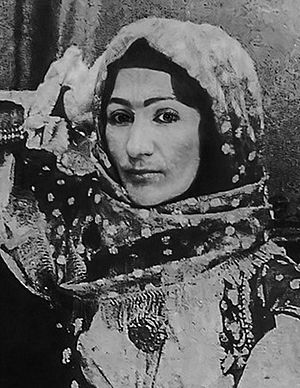Khurshidbanu Natavan facts for kids
Quick facts for kids
Khurshidbanu Natavan
|
|
|---|---|

Khurshidbanu Natavan
|
|
| Native name |
Xurşidbanu Utsmiyeva
|
| Born | Xurşidbanu Natəvan August 6, 1832 Shusha, Georgia Governorate, Caucasus Viceroyalty, Russian Empire |
| Died | October 2, 1897 (aged 65) Shusha, Elisabethpol Governorate, Caucasus Viceroyalty, Russian Empire |
| Resting place | Aghdam, Azerbaijan |
| Language | Azerbaijani Persian |
| Genre |
|
| Spouse | Khasay Khan Utsmiyev |
| Relatives | Mehdigulu Khan Javanshir |
Khurshidbanu Natavan (Azerbaijani: خورشیدبانو ناتوان / Xurşidbanu Natəvan; born August 6, 1832 – died October 2, 1897) was an important Azerbaijani poet. She was also a philanthropist, meaning she helped many people and supported good causes. Many people consider her one of the best lyrical poets from Azerbaijan. Her poems were written in either Azerbaijani or Persian. She was especially famous for her beautiful lyrical ghazals.
Natavan was the daughter of Mehdigulu Khan. He was the last ruler of the Karabakh Khanate, which existed from 1748 to 1822.
Contents
Life Story
Khurshidbanu Natavan was born on August 5, 1832. Her birthplace was Shusha, a town in what is now Azerbaijan. Her parents were Mehdigulu Khan and Badir Jahan Begüm.
She was the only child in her family. Because of this, she was the only one to inherit a lot of land and wealth from her father. People often called her the "daughter of the khan." Her name, Khurshid Banu, comes from Persian and means "Lady Sun." Her pen name, Natavan, also comes from Persian and means powerless. She was named after her grandmother, Khurshud Begüm.
Becoming a Leader
When she was 14, after her father passed away, Natavan inherited a large amount of land. This included many households and villages. Her aunt, Gawhar agha, helped raise her. Her aunt also taught her about music, poetry, and painting. Around 1847, she likely married a nobleman named Khasay Utsmiev.
In 1861, after her mother died, Natavan inherited even more villages. She used her wealth to help her community. She started and supported the first groups for writers in Shusha and all of Azerbaijan. One of these groups, called Majlis-i Uns ("Society of Friends"), became very popular. It brought together many talented poets and thinkers in Karabakh.
Helping Her Community
Natavan was very involved in helping others. She worked to improve the social and cultural life in Karabakh. One of her most famous actions was building a water main in Shusha in 1872. This project solved the town's water problems. A local newspaper at the time wrote that Natavan would be remembered for generations. The aqueduct she built, made of white stones, was called "Natavan springs" by the local people. These springs were also seen as important historical sites.
Natavan also did a lot to help the famous Karabakh horse breed. Her Karabakh horses were shown at big events. They took part in the Exposition Universelle (1867) in Paris and agricultural exhibitions in Moscow (1869) and Tbilisi (1882). Her horses won gold medals and special awards. For example, at the 1869 exhibition, her horses Meymun and Tokmak won silver and bronze medals. At the Paris exhibition in 1867, one of her horses, Khan, won a silver medal.
Her Poetry
Natavan's poems often focused on themes like kindness, friendship, and love. Her ghazals and ruba'yat were very emotional. They showed the feelings and struggles of a woman who faced sadness in her family life, including losing her son. Today, many of her poems are still used in folk songs.
Natavan's Resting Place
Natavan passed away in Shusha on October 2, 1897. She was buried in the Imarat Cemetery in Aghdam. After the First Nagorno-Karabakh war, her tomb was damaged. In January 2021, after the area was returned to Azerbaijan, a photojournalist visited the cemetery. He reported that the cemetery was destroyed and Natavan's tomb was damaged.
Monument in Shusha
A monument of Natavan once stood in Shusha. It was created by the artist Hayat Abdullayeva. This monument, along with others of famous Azerbaijanis like Hajibekov and Bulbul, used to decorate the main streets of Shusha. According to the Azerbaijani government, these monuments were badly damaged.
Polad Bulbuloghlu, who was the Minister of Culture of Azerbaijan at the time, later bought these bronze busts. He found them in a scrap metal yard in Georgia. He then had them brought to Baku.
A writer named Thomas de Waal saw the monuments in Baku. He described them as "forlorn and pocked with bullets." He mentioned that Natavan's monument showed her as "an earnest girl in a head scarf reading a book, missing a thumb."
For many years, the monuments were kept in the yard of the Azerbaijani Museum of Arts in Baku. On January 16, 2021, after the city was recaptured, Natavan's bust was returned to Shusha.
Her Family
Natavan likely married a nobleman named Khasay Utsmiev in 1847. They had two children together:
- Mehdigulu Khan Vafa — A poet and a lieutenant-colonel in the army.
- Khanbike Khanum (1856-1921) — Also a poetess.
Later, in 1866, she married Seyyid Huseyn Agamirov (1833-1891). They had five children:
- Mir Abbas Agha (1868-1885)
- Mir Hasan Agha (1870-1903)
- Mir Jabbar Agha (?-1914?)
- Sara Begum
- Hajar Bike (1869-?)
See also
 In Spanish: Khurshidbanu Natavan para niños
In Spanish: Khurshidbanu Natavan para niños
- House of Khurshidbanu Natavan
- Bust of Khurshidbanu Natavan


